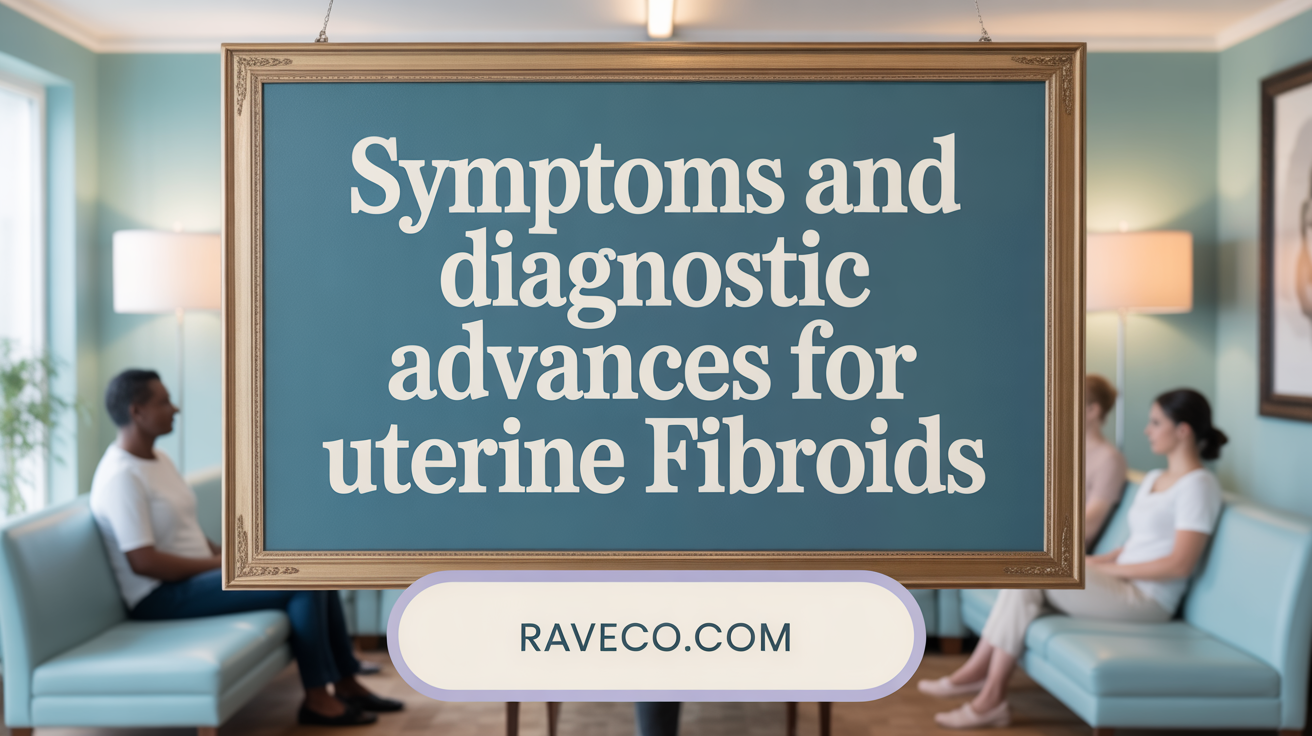Recognizing the Right Time to Address Female Infertility: Key Indicators and Expert Care in Queens

Understanding the Prevalence and Impact of Uterine Fibroids
Uterine fibroids, the most common benign tumors in women of reproductive age, affect a significant portion of the female population worldwide. These growths range in symptom severity, from asymptomatic cases to those causing substantial health burdens such as abnormal bleeding, pain, and fertility challenges. The financial impact and health management of uterine fibroids represent a growing concern in clinical practice. This article provides an in-depth review of fibroid epidemiology, removal methods, recurrence rates, and the latest trends in treatment modalities to inform patients and healthcare providers alike.
Epidemiology and Economic Burden of Uterine Fibroids

What is the prevalence and incidence of uterine fibroids globally?
Uterine fibroids (UF) are extremely common benign tumors affecting women worldwide. The prevalence varies significantly across different regions, with estimates indicating that between 4.5% and 68.8% of women are affected depending on the population studied and diagnostic methods used. In the United States, the incidence was approximately 101.4 cases per 10,000 person-years in 2014, especially high among women aged 45–49. By age, nearly 60% of women aged 35–49 and about 80% of women over 50 are diagnosed with fibroids. The condition affects women of reproductive age, with symptoms in about 30% of cases, leading to substantial health concerns.
What are the economic costs associated with fibroids?
The impact of uterine fibroids extends beyond health to cause a significant economic burden. In the United States alone, costs related to fibroids can reach up to $34 billion annually. These costs encompass direct healthcare expenses—including hospitalizations, surgical procedures such as hysterectomies and myomectomies, and minimally invasive treatments like uterine artery embolization—as well as indirect costs related to loss of productivity. Uterine fibroids are responsible for around 40%–60% of all hysterectomies, constituting a major driver of healthcare expenditure.
How do demographic factors and risk influences affect fibroid development?
Certain demographic groups and risk factors predispose women to developing fibroids. Notably, black women have a higher prevalence, with 60% diagnosed in the 35–49 age group and 80% over 50. Other factors include genetic predisposition, early menarche, late menopause, obesity, hypertension, polycystic ovarian syndrome, and nulliparity. Advances in imaging have increased diagnosis rates, especially among women delaying childbirth. Long-term data from China also indicate rising mortality and disability-adjusted life years (DALYs), underscoring a growing health burden influenced by lifestyle and socioeconomic changes. Understanding these influences helps in targeting prevention and management strategies.
Risk Factors and Demographics Influencing Fibroid Development

Influences of ethnicity, genetics, and hormonal factors
Uterine fibroids (UF) are affected by various biological and environmental factors. Ethnicity plays a significant role, with studies showing a higher prevalence in black women. Genetics also contribute, as a family history of fibroids increases the likelihood of developing these tumors. Hormonal influences, particularly estrogen and progesterone, are crucial, since UF tend to grow in response to these hormones. Other risk factors include obesity and hormone replacement therapy, which can modify hormone levels and impact fibroid growth.
Higher prevalence in black women
Black women are more affected by UF, with approximately 60% diagnosed by the ages of 35–49 and prevalence rising to about 80% over age 50. This increased risk has been linked to genetic predispositions and differences in hormonal profiles. The higher incidence in black women often correlates with more severe symptoms and may influence treatment decisions.
Role of age, hypertension, and reproductive history
Age is a major factor, with UF becoming more common as women approach their forties and fifties. They can regress after menopause due to declining hormone levels. Hypertension has been identified as an associated risk factor, potentially due to shared vascular or hormonal pathways. Reproductive history also affects fibroid development; early menarche and nulliparity (having no children) are associated with an increased risk. Conversely, pregnancy can sometimes inhibit fibroid growth, although it may also lead to certain types of fibroid-related complications.
| What influences fibroid development? | Effect | Additional Notes |
|---|---|---|
| Ethnicity | High in black women | 60% diagnosed by 35–49 years |
| Genetics | Family history increases risk | Hereditary predispositions |
| Hormonal factors | Growth in response to estrogen, progesterone | Impacted by obesity and HRT |
| Age | Higher risk in 40s and 50s | Often regress after menopause |
| Hypertension | Possible risk factor | Shares vascular and hormonal pathways |
| Reproductive history | Early menarche, nulliparity | May heighten fibroid risk |
Understanding these factors helps guide screening and treatment planning, especially in high-risk populations.
Clinical Manifestations and Diagnosis of Fibroids

What are the common symptoms of fibroids?
Uterine fibroids often go unnoticed because many women are asymptomatic. When symptoms do appear, they typically include abnormal uterine bleeding such as heavy periods, pelvic pressure, pain, and sometimes fertility issues. These symptoms can significantly impact quality of life, especially if the fibroids grow large or interfere with uterine function.
How are fibroids diagnosed using imaging?
Imaging plays a crucial role in diagnosing fibroids. Transvaginal ultrasonography is the most commonly used first-line imaging technique, providing clear images of the uterus and fibroids' size, location, and number. Magnetic Resonance Imaging (MRI) offers higher resolution and detailed tissue characterization, especially useful in complex cases or when planning surgical interventions. Advances in these imaging modalities have increased detection rates, enabling more targeted treatment strategies.
How to differentiate between symptomatic and asymptomatic fibroids?
Most women with fibroids experience no symptoms and remain unaware of their condition. In contrast, symptomatic fibroids are usually larger or located in a way that causes noticeable issues, such as abnormal bleeding or pelvic pressure. Diagnostic imaging helps differentiate these two types by revealing fibroids' size, position, and potential impact on the uterus. Identifying the presence of symptoms alongside imaging results guides appropriate treatment choices.
| Diagnostic Method | Primarily Used For | Advantages | Limitations |
|---|---|---|---|
| Ultrasonography | Initial screening and detection | Widely available, non-invasive, cost-effective | Less detailed for complex cases |
| Magnetic Resonance Imaging | Detailed assessment, pre-surgical planning | High resolution, precise location, tissue characterization | More expensive, less accessible in some settings |
Understanding the presentation and accurate diagnosis of fibroids is essential for effective management. While many women remain asymptomatic, those with significant symptoms benefit from imaging studies that inform treatment options, ranging from minimally invasive procedures to surgical interventions.
Current Best Practices in Management and Treatment Selection

What are the current management guidelines and best practices for treating fibroids?
Managing uterine fibroids relies heavily on a personalized approach that emphasizes the individual patient's characteristics, preferences, and overall health. Initial diagnosis is typically achieved through transvaginal ultrasound, which provides detailed images of fibroid size, location, and number. In complex cases, magnetic resonance imaging (MRI) may be employed for more precise assessment.
For women without symptoms, watchful waiting is generally the recommended course. Many asymptomatic fibroids remain stable or regress after menopause, so intervention is often unnecessary. However, when symptoms such as abnormal bleeding, pelvic pressure, or pain interfere with quality of life, treatment becomes necessary.
Medical therapies form the first line of intervention for symptomatic fibroids. Options include gonadotropin-releasing hormone (GnRH) antagonists, which temporarily shrink fibroids; progestin-releasing intrauterine devices (IUDs) that reduce bleeding; tranexamic acid, or combined oral contraceptives to manage bleeding episodes.
In cases where surgery is indicated, minimally invasive methods are prioritized. Myomectomy—either hysteroscopic or laparoscopic—aims to remove fibroids while preserving the uterus, making it suitable for women wishing to maintain fertility. Alternatively, hysterectomy, the complete removal of the uterus, offers definitive treatment with high satisfaction but is reserved for women who no longer desire future pregnancies or for large, multiple fibroids.
Other less invasive procedures, such as uterine artery embolization (UAE) and high-intensity focused ultrasound (HIFU), have gained popularity. UAE involves blocking blood flow to fibroids, leading to shrinkage, and has demonstrated outcomes comparable to surgery with shorter recovery times. HIFU, a non-invasive technique that uses focused ultrasound waves, has shown promising results for symptom relief, especially in overweight or obese women.
Overall, current guidelines advise a tailored approach, weighing the benefits and risks of each option, optimizing symptom control, fertility preservation, and patient comfort. Ongoing research continues to refine these practices, aiming for safe and effective long-term management of fibroids.
Evaluating Fibroid Size and Treatment Necessity
 There is no specific size of fibroid that is universally considered dangerous or requiring treatment solely based on its dimensions. Typically, treatment decisions hinge on symptom presentation rather than the fibroid’s size alone.
There is no specific size of fibroid that is universally considered dangerous or requiring treatment solely based on its dimensions. Typically, treatment decisions hinge on symptom presentation rather than the fibroid’s size alone.
Many small fibroids remain asymptomatic and often do not need any intervention. In contrast, larger fibroids—those exceeding 10 centimeters—may cause significant symptoms that warrant treatment, but size is not the only factor.
Common symptoms caused by fibroids include pressure effects on adjacent organs, urinary issues such as frequency or retention, pelvic pain, and abnormal bleeding. These symptoms can significantly impact a woman’s quality of life and often indicate the need for medical management.
The location of the fibroid also plays a crucial role. Submucosal fibroids protrude into the uterine cavity and are more likely to cause bleeding and fertility problems, whereas intramural or subserosal fibroids might present with pressure or pain.
In essence, doctors assess the severity of symptoms and fibroid location to decide on treatment. Size alone is not the determining factor, emphasizing a symptom-driven approach to managing uterine fibroids.
Overview of Surgical Fibroid Removal Methods

Myomectomy Techniques and Patient Fertility Considerations
Myomectomy involves the surgical removal of uterine fibroids while preserving the uterus, making it a preferred option for women wishing to maintain fertility. There are different approaches, including open abdominal myomectomy, laparoscopic, and hysteroscopic myomectomy.
Laparoscopic myomectomy, performed through small incisions, offers benefits like reduced recovery time and less postoperative pain. Hysteroscopic myomectomy, which is minimally invasive, is specifically used for submucosal fibroids that protrude into the uterine cavity.
Studies show that hysteroscopic myomectomy can improve pregnancy rates, especially when fibroids distort the uterine cavity, though evidence on reducing miscarriage remains limited. Overall, myomectomy can lead to significant symptom relief and better fertility outcomes for suitable patients.
Hysterectomy as Definitive Treatment and Its Outcomes
Hysterectomy — the complete removal of the uterus — remains a definitive surgical option, especially for women not concerned about future fertility. It guarantees removal of all fibroids, thereby eliminating the risk of recurrence.
Patients typically report high satisfaction due to symptom relief, including decreased bleeding, pelvic pressure, and pain. However, hysterectomy involves significant surgery with longer recovery times and potential hormonal consequences if the ovaries are removed.
Respective Complication and Satisfaction Rates
Myomectomy is associated with higher morbidity, including risks of bleeding, infection, and recurrence of fibroids, which can be as high as 50% within five years. In contrast, hysterectomy offers a definitive solution with a very low recurrence rate.
Recent studies highlight that minimally invasive procedures like uterine artery embolization (UAE) and High-Intensity Focused Ultrasound (HIFU) show promising outcomes, including lower complication rates and quicker recovery.
Overall patient satisfaction tends to be higher with hysterectomy due to complete symptom resolution, yet fewer invasive options are appreciated for their preservation of the reproductive organ. The choice of procedure depends heavily on individual patient needs, age, and desire for future pregnancy.
Minimally Invasive and Non-Surgical Fibroid Treatments
What are the common and emerging non-surgical treatments for fibroids?
In recent years, several minimally invasive and non-surgical options have gained popularity for treating uterine fibroids, offering effective symptom relief with less recovery time than traditional surgery.
One of the most established methods is uterine artery embolization (UAE). This procedure involves threading a catheter to block blood flow to the fibroids, causing them to shrink. Studies show that UAE can reduce fibroid size by 20%–60% and provide sustained symptom improvement for at least three years. The recurrence rate after UAE is around 23% over ten years, and many women avoid hysterectomy or myomectomy with this approach. Complications are generally mild but may include post-procedural pain and vascular access site issues.
Another promising technique is MRI-guided focused ultrasound (MRgHIFU). This non-invasive procedure concentrates high-intensity ultrasound waves to heat and destroy fibroid tissue. A retrospective study comparing MRgHIFU to laparoscopic myomectomy found that patients experienced significantly better symptom reduction and quality of life scores at 6 to 12 months post-treatment. Additionally, MRgHIFU typically involves minimal trauma, no need for general anesthesia, and quicker recovery, making it suitable for overweight or obese women.
Transcervical fibroid ablation, using radiofrequency energy (like the Acessa® system), and laparoscopic radiofrequency ablation (Lap-RFA) are additional minimally invasive options. These procedures target fibroids via small incisions or transcervical access, preserving the uterus and reducing hospital stays.
Emerging medical therapies also include hormonal treatments such as GnRH antagonists (e.g., relugolix, linzagolix) and selective progesterone receptor modulators like Oriahnn and Myfembree. These medications help control symptoms and reduce fibroid size by modulating hormonal influences.
Natural and alternative treatments like vitamin D supplementation and green tea extract (EGCG) are under investigation for their potential roles in fibroid management, though evidence remains limited.
Advantages of these minimally invasive and medical approaches include reduced trauma, shorter recovery periods, and the potential to preserve fertility.
| Treatment Method | Approach | Benefits | Limitations |
|---|---|---|---|
| Uterine Artery Embolization (UAE) | Catheter-based blockage | Symptom relief, Uterus preservation | Possible recurrence, mild complications |
| MRI-guided Focused Ultrasound | Non-invasive ultrasound targeting | Quick recovery, organ preservation | Limited availability, fibroid size restrictions |
| Transcervical Radiofrequency Ablation | Minimally invasive, transcervical access | Uterus preservation, outpatient procedure | Not suitable for large or multiple fibroids |
| Medications (GnRH antagonists, SPRMs) | Hormonal modulation | Symptom control, size reduction | Not a cure, limited long-term data |
Overall, the landscape of fibroid treatment is broadening with options that balance effectiveness with patient comfort and safety. These innovations are especially valuable for women seeking alternatives to traditional surgery, aiming for symptom relief with minimal disruption to their lives.
Recurrence Rates After Fibroid Treatments: Surgical and Non-Surgical Perspectives
 Long-term management of uterine fibroids involves understanding the likelihood of recurrence after different treatment options. A notable review at Kaiser Permanente Northern California highlighted that women who undergo myomectomy experience the lowest reintervention rate, standing at approximately 20.6% after 7 years. This indicates that around one in five women might need another procedure within this period, primarily due to fibroid regrowth or symptom recurrence.
Long-term management of uterine fibroids involves understanding the likelihood of recurrence after different treatment options. A notable review at Kaiser Permanente Northern California highlighted that women who undergo myomectomy experience the lowest reintervention rate, standing at approximately 20.6% after 7 years. This indicates that around one in five women might need another procedure within this period, primarily due to fibroid regrowth or symptom recurrence.
Other treatments show higher reintervention rates. Uterine artery embolization (UAE), a minimally invasive procedure aiming to shrink fibroids, has a recurrence rate of about 23% over 10 years. In comparison, endometrial ablation and hysteroscopic myomectomy exhibit rates of 35.5% and 37%, respectively. Interestingly, nearly two-thirds of follow-up procedures after these treatments are hysterectomies, which permanently remove the uterus and eliminate fibroid recurrence.
The timing of fibroid regrowth varies among individuals. Most recurrences are observed around 3.8 years post-treatment, according to follow-up data. Recurrence can occur as early as two years after surgery, especially in cases where multiple fibroids were present initially or when the fibroids were larger.
Are surgical approaches influencing recurrence risk? The choice of surgical method impacts the likelihood of fibroid recurrence. Laparoscopic myomectomy tends to have higher recurrence rates compared to open abdominal myomectomy. Factors such as residual fibroid tissue after surgery, pre-existing genetic predisposition, hormone levels, and lifestyle also contribute to regrowth. Studies have identified residual fibroids and family history as significant predictors of recurrence.
In terms of timing, recurrence often manifests within five years, but some women may experience growth even beyond ten years. Regular follow-up is crucial for early detection and management. Monitoring typically involves ultrasound imaging to assess for new or remaining fibroids.
Ultimately, the risk of fibroid regrowth underscores the importance of individualized treatment planning. Patients should be informed about the potential for recurrence, the need for ongoing surveillance, and options if symptoms re-emerge. Long-term strategies may include managing hormonal influences and considering definitive procedures like hysterectomy for those seeking complete resolution.
Below is a summary table comparing recurrence rates, timing, and influencing factors:
| Treatment Method | Reintervention Rate (%) | Typical Timeframe for Recurrence | Factors Increasing Recurrence | Long-term Management Tips |
|---|---|---|---|---|
| Myomectomy (open/laparoscopic) | 20.6 (7-year rate) | around 3.8 years (median) | Multiple fibroids, residual tissue, genetic factors | Regular ultrasound, hormonal regulation |
| Uterine artery embolization | 23% at 10 years | 3-5 years | Fibroid size, incomplete infarction | Hormonal management, follow-up imaging |
| Endometrial ablation | 35.5% | Variable | Type and location of fibroids | Symptom monitoring, possible re-treatment |
| Hysterectomy | 0% (permanent removal) | No recurrence (permanent) | Not applicable | Postoperative care, symptom resolution |
Understanding these factors helps patients and clinicians make informed decisions tailored to individual needs, balancing risks of recurrence with the benefits of each treatment approach.
Comparative Effectiveness and Safety of Fibroid Treatments
How do myomectomy, UAE, endometrial ablation, and hysteroscopic myomectomy compare in terms of recurrence and complication rates?
Research indicates that among common fibroid treatments, surgical removal via myomectomy has the lowest chance of needing another intervention, with a reintervention rate of just 20.6% over a period of seven years. Conversely, less invasive procedures like uterine artery embolization (UAE) show higher recurrence, with about 23% of patients needing additional treatment within ten years. Other methods, such as endometrial ablation and hysteroscopic myomectomy, have even higher reintervention rates—35.5% and 37%, respectively.
The median time before a follow-up procedure is approximately 3.8 years. Most follow-ups (around two-thirds) lead to hysterectomy, the surgical removal of the uterus, often as a subsequent step. In terms of safety, minimally invasive approaches like UAE and high-intensity focused ultrasound (HIFU) typically have lower complication rates compared to open surgeries, with HIFU showing a complication rate of around 9.33%, notably less than laparoscopic myomectomy, which stands at 21.3%. These differences highlight the benefits of less invasive options, especially regarding recovery and risks.
How satisfied are patients with different fibroid treatment options?
Patient satisfaction depends on symptom relief and the procedure’s impact on quality of life. Myomectomy and hysterectomy often provide high satisfaction because they effectively eliminate symptoms like bleeding and pressure. Notably, hysterectomy, which removes the entire uterus, ensures that fibroids do not recur, leading to near certainty of symptom resolution.
Minimally invasive procedures like HIFU have demonstrated promising results, with patients reporting significant improvements in symptom severity and quality of life at 6 months and 1 year post-treatment. These approaches also offer advantages such as shorter hospital stays, less trauma, and quicker recovery times.
What are the benefits of minimally invasive strategies such as HIFU?
High-Intensity Focused Ultrasound (HIFU) is an effective, safe, and relatively new treatment for uterine fibroids. It can be performed without general anesthesia, reducing overall risk and recovery time. Studies show that patients undergoing HIFU experienced better symptom relief and higher quality of life scores compared to traditional surgical options. Moreover, the complication rate for HIFU is considerably lower, and importantly, no fibroid enlargement or recurrence was observed within one-year follow-up.
The ability to perform HIFU on overweight or obese women with minimal trauma makes it an attractive option. Its minimally invasive nature and quick recovery period make HIFU a favorable choice, especially for women seeking effective relief with fewer risks and shorter downtime.
| Treatment Method | Reintervention Rate (%) | Typical Follow-up Duration | Notable Advantages |
|---|---|---|---|
| Myomectomy | 20.6 | 7 years | Lowest reintervention, symptom relief |
| Uterine artery embolization | 23 | Up to 10 years | Uterus preservation, quick recovery |
| Endometrial ablation | 35.5 | Variable, median ~3.8 years | Less invasive, but higher recurrence |
| Hysteroscopic myomectomy | 37 | Variable | Good for submucosal fibroids, symptom relief |
| High-Intensity Focused Ultrasound (HIFU) | ~0 (no recurrence reported at 1 year) | 1 year | Minimally invasive, low complication rates |
This overview highlights that treatment choice should consider individual patient needs, symptom severity, reproductive goals, and risk profiles to optimize outcomes.
Nomogram Development and Predictors of Fibroid Recurrence
What are the factors influencing recurrence of uterine fibroids?
Understanding what contributes to fibroid recurrence is essential for personalized patient management. Several factors have been identified as significant predictors. These include the specific subtype of fibroid (such as submucosal, intramural, or subserosal), the size of the fibroids at the time of treatment, and whether residual fibroids remain after a procedure.
Additionally, a patient's pregnancy history plays a role; for example, pregnancy after treatment may reduce recurrence risk. Family history of fibroids and the number of fibroids observed on ultrasound are also important, as they can increase the likelihood of recurrence. Interestingly, submucosal fibroids appear to offer some protective effect against recurrence.
How was the predictive model developed and validated?
Researchers used advanced statistical techniques, notably LASSO (Least Absolute Shrinkage and Selection Operator) regression, to select the most relevant predictors from a larger set of variables. They analyzed data from 678 patients, split into training and validation groups in a 7:3 ratio.
The model's performance was evaluated through multiple methods. ROC (Receiver Operating Characteristic) curves measured its discrimination ability, with AUCs of 0.834 in training and 0.799 in validation, indicating good accuracy. Calibration plots, the Hosmer-Lemeshow test, and decision curve analysis further confirmed the model's reliability and clinical usefulness.
How can clinicians apply this predictive tool?
The constructed nomogram serves as a practical tool to estimate an individual patient's risk of fibroid recurrence post-treatment. By inputting specific patient variables—like fibroid subtype, residual size, and family history—clinicians can generate a personalized risk score.
This personalized approach helps guide treatment decisions and follow-up strategies, potentially leading to better patient outcomes. High-risk patients might require closer monitoring or additional interventions, while those at lower risk could avoid unnecessary procedures.
| Predictor Variables | Impact on Recurrence | Notes |
|---|---|---|
| Fibroid subtype | Significant | Submucosal fibroids are protective |
| Fibroid size | Increased risk | Larger size correlates with higher recurrence |
| Residual fibroids | Strong predictor | Presence increases recurrence likelihood |
| Pregnancy after treatment | Reduces risk | Post-treatment pregnancy may lower recurrence |
| Family history | Increased risk | Hereditary factors influence outcomes |
| Number of fibroids on ultrasound | Higher number increases risk | Greater fibroid load signifies higher risk |
By integrating these predictors into a single, user-friendly tool, healthcare providers can better stratify patient risk and tailor management plans accordingly.
Impact of Fibroids and Treatments on Fertility and Pregnancy Outcomes

What is the impact of fibroids on fertility and reproductive health?
Uterine fibroids are common benign tumors encountered in women of reproductive age, with a prevalence ranging from 4.5% to as high as 68.8% in different populations. Their presence has often raised concerns about potential adverse effects on fertility and pregnancy outcomes. However, current evidence indicates that, generally, fibroids do not significantly reduce the chances of conceiving nor do they necessarily increase the risk of miscarriage.
Most women with fibroids proceed to pregnancy without complications. Nevertheless, fibroids that distort the uterine cavity—especially submucosal types—are associated with difficulties in implantation, miscarriage, and early pregnancy loss. This is because cavity-distorting fibroids can interfere with the normal environment of the endometrium, adversely affecting embryo implantation.
Evidence supporting myomectomy for cavity-distorting fibroids
Myomectomy, the surgical removal of fibroids, has been shown to improve fertility mainly when performed for cavity-distorting fibroids. Specifically, hysteroscopic myomectomy—a minimally invasive technique—has fair evidence supporting its role in enhancing clinical pregnancy rates and reducing early pregnancy losses. This procedure allows for precise removal of submucosal fibroids, improving the uterine cavity and creating a more favorable environment for implantation.
The benefits of myomectomy are particularly evident in women with submucosal fibroids that distort the uterine cavity. Several studies suggest that operative removal can restore normal uterine anatomy, thereby enhancing the likelihood of successful pregnancy.
Outcomes after hysteroscopic myomectomy
Hysteroscopic myomectomy has demonstrated positive effects on reproductive outcomes, especially in women with cavity-distorting fibroids. Evidence shows an increase in clinical pregnancy rates post-procedure and a reduction in early pregnancy loss.
However, data on live birth rates and long-term pregnancy outcomes remain limited; most studies are observational with some heterogeneity in their design, population, and fibroid characteristics. Despite the promising results, larger randomized controlled trials are needed to definitively establish its efficacy.
Limitations of current research and observational studies
Most existing research on fibroids and reproductive outcomes is observational, which introduces certain limitations. These studies often have variations in methodology, patient populations, and fibroid types, making it difficult to draw conclusive evidence.
Furthermore, many studies have small sample sizes and inconsistent definitions of outcomes such as pregnancy loss and live birth. The heterogeneity in study design hampers the ability to establish firm guidelines or recommendations.
In summary, while fibroids—particularly cavity-distorting types—may impact fertility negatively, the evidence suggests that myomectomy can be beneficial for improving reproductive outcomes in selected cases. For asymptomatic women with non-cavity-distorting fibroids, surgery is generally not advised solely for fertility reasons, emphasizing the importance of personalized medical assessment.
Postoperative Management to Reduce Fibroid Recurrence
What are effective approaches to prevent fibroids from growing back after myomectomy?
Long-term management following myomectomy focuses on reducing the risk of fibroid recurrence. Since hormonal influences, especially estrogen and progesterone, play a central role in fibroid growth, maintaining hormonal balance is crucial. Medications like gonadotropin-releasing hormone (GnRH) agonists or selective progesterone receptor modulators (SPRMs) may be used under medical supervision to suppress hormone production temporarily and inhibit fibroid regrowth.
Lifestyle modifications are also vital. Consuming a balanced diet rich in fruits, vegetables, and lean proteins and avoiding red meats can help modulate hormonal levels. Maintaining a healthy weight through regular physical activity not only improves overall health but also reduces obesity-related hormonal disruptions that promote fibroid development.
Regular follow-up appointments, including pelvic exams and imaging such as ultrasounds, are essential for early detection of new fibroids. Early intervention can prevent complications and reduce the need for additional surgeries.
Some treatment options like uterine artery embolization (UAE) have demonstrated lower recurrence rates compared to myomectomy, especially when combined with hormonal therapy.
Emerging research suggests that vitamin D supplementation may play a role in decreasing fibroid size and recurrence. Vitamin D has been shown to inhibit fibroid cell proliferation in laboratory studies, and some clinical evidence supports its benefit. However, more research is needed to establish clear guidelines.
In summary, a combination of hormonal management, healthy lifestyle choices, routine monitoring, and exploring adjunctive therapies such as vitamin D may effectively reduce fibroid recurrence after surgical removal.
Dietary and Lifestyle Influences on Fibroid Growth and Management
What role does diet play in hormone balance and fibroid development risk?
Diet significantly impacts hormone levels, which can influence the growth of uterine fibroids. Certain foods and eating patterns help regulate estrogen and other hormones, potentially impacting fibroid development. A balanced diet that promotes hormone stability is therefore beneficial.
Are there specific food groups and nutrients that may be beneficial or harmful?
Consuming a variety of healthy foods may help manage fibroid growth. Fruits, vegetables, legumes, whole grains, and fish—characteristic of a Mediterranean diet—are linked to lower estrogen levels and improved hormonal balance. These foods contain fiber and antioxidants that support detoxification and reduce inflammation.
Conversely, foods high in processed sugars, red meats, and dairy may increase estrogen levels and promote fibroid growth. Phytoestrogens found in soy and flaxseed can also influence hormone activity, although their exact effect remains uncertain and may vary between individuals.
High potassium foods like bananas, spinach, and sweet potatoes support hormone regulation, while limiting alcohol intake can also be beneficial.
How does weight management and avoidance of environmental hormone disruptors influence fibroid management?
Maintaining a healthy weight is crucial, as obesity has been associated with higher estrogen production, which may encourage fibroid growth. Achieving and sustaining a healthy body weight can help reduce hormonal imbalances.
In addition to diet and weight control, avoiding exposure to environmental endocrine-disrupting chemicals—found in plastics, pesticides, and some personal care products—can lower the risk of fibroid growth. Using BPA-free products, choosing organic produce, and minimizing plastic use are practical steps.
Are there dietary approaches or foods known to help shrink fibroids?
While direct evidence for foods that shrink fibroids is limited, adopting certain nutritional strategies may help manage their growth. Emphasizing a diet rich in fruits, vegetables, and omega-3 fatty acids can promote overall hormonal health and potentially slow fibroid progression. Limiting intake of processed foods, red meats, and soy-based products might reduce estrogenic stimulation.
Overall, a holistic approach combining a healthy diet, weight management, and minimizing environmental toxin exposure offers the best support in fibroid management.
Long-Term Trends and Future Directions in Fibroid Management

Increasing prevalence and diagnostic rates
Uterine fibroids (UF) are among the most common benign gynecologic tumors, with a prevalence that ranges widely based on geography and population but can affect up to 60% of women. Advances in imaging technology, such as high-resolution ultrasound and MRI, have led to more frequent detection, often before symptoms develop. This increase in diagnosis is compounded by lifestyle factors like obesity and hormone therapy, which influence fibroid growth.
Shifts away from hysterectomy towards uterus-sparing treatments
Historically, hysterectomy was the standard approach for symptomatic fibroids, especially for women who did not wish to preserve fertility. However, recent trends show a gradual shift towards less invasive, uterus-preserving options. Procedures like myomectomy and minimally invasive therapies are becoming more popular, partly due to their lower morbidity and high patient satisfaction. Data indicates that nearly two-thirds of follow-up procedures after treatments involve hysterectomy, but the move is towards alternatives that maintain uterine integrity.
Innovation in minimally invasive and medical therapies
Newer treatment modalities are expanding options for women with fibroids. Uterine artery embolization (UAE), high-intensity focused ultrasound (HIFU), and medical therapies like GnRH agonists and selective progesterone receptor modulators (SPRMs) are providing effective symptom control with fewer complications. For example, HIFU has shown promising results with minimal trauma, lower complication rates, and good symptom relief, especially suitable for overweight and obese women. Ongoing research into these techniques aims to improve long-term outcomes and reduce recurrence risks.
Need for continued research and personalized treatment plans
Current evidence suggests that recurrence rates and treatment responses vary based on fibroid type and patient characteristics. Development of predictive tools, such as nomograms incorporating factors like fibroid subtype, size, and residual fibroids, can help tailor management strategies. Future research should focus on long-term outcomes, fertility impacts, and patient-specific factors to optimize individualized care and improve quality of life. The growing understanding of fibroid biology and the evolution of treatments promise to refine management approaches further.
Advancing Fibroid Care Through Evidence and Innovation
The management of uterine fibroids continues to evolve with improving diagnostic techniques, expanding therapeutic options, and enhanced understanding of recurrence risk factors. While surgical removal, particularly myomectomy, remains a mainstay for symptomatic relief and fertility preservation, the advent of minimally invasive procedures and novel medical therapies offer promising alternatives with reduced morbidity. Personalized care strategies that integrate clinical features, patient preferences, and predictive modeling tools can optimize treatment outcomes and reduce recurrence. Furthermore, lifestyle modifications and adjunctive measures may contribute to long-term management success. Ongoing research and innovation are essential to refine fibroid care, improve patient quality of life, and address the substantial health and economic burden posed by this prevalent condition.
References
- Comparison of fibroid treatment finds surgical removal has fewest ...
- Uterine fibroids: a narrative review of epidemiology and ...
- Development and validation of a nomogram-based predictive model ...
- Removal of myomas in asymptomatic patients to improve fertility and ...
- Review of the conservative surgical treatment of uterine fibroids
- Application of high intensity focused ultrasound in the treatment of ...
- The long-term trend of uterine fibroid burden in China from 1990 to ...





.png)